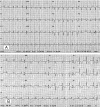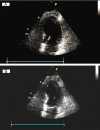Subacute stent thrombosis and stress-induced cardiomyopathy: trigger or consequence?
- PMID: 23991353
- PMCID: PMC3751684
Subacute stent thrombosis and stress-induced cardiomyopathy: trigger or consequence?
Abstract
Stress-induced cardiomyopathy or Takotsubo cardiomyopathy (TCM) is a unique syndrome, characterized by transient left ventricular (LV) apical ballooning without significant coronary arteries stenosis, affecting mainly menopausal women. We present the case of a 70 year old woman with subacute stent thrombosis (ST) at the level of the right coronary artery and transient apical ballooning with normal flow of left and circumflex coronary arteries. TCM is frequently associated with emotional stress, but to date no case of ST triggering TCM have been reported.
Keywords: Stress-induced cardiomyopathy; Takotsubo cardiomyopathy; subacute stent thrombosis.
Figures





References
-
- Gianni M, Dentali F, Grandi AM, Sumner G, Hiralal R, Lonn E. Apical balloning sindrome or takotsubo cardiomyopathy: a systematic review. Eur heart J. 2006;27:1523–9. - PubMed
-
- Balaguer-Malfagón JR, Pomar-Domingo F, Vilar-Herrero JV, Planas-del Viejo AM, Pérez-Fernández E. Stent thrombosis in the modern era: incidence, outcome and predictive factors. Rev Esp Cardiol. 2006;59:842–5. - PubMed
-
- Wittstein IS, Thiemann DR, Lima JA, Baughman KL, Schulman SP, Gerstenblith G, Wu KC, Rade JJ, Bivalacqua TJ, Champion HC. Neurohumoral features of myordial stunning due to sudden emotional stress. N Engl J Med. 2005;352:539–48. - PubMed
-
- Spes C, Knape A, Mudra H. Recurrent tako-tsubo-like left ventricular dysfunction (apical ballooning) in a patient with pheochromocytoma - a case report. Clin Res Cardiol. 2006;95:307–11. - PubMed
Publication types
LinkOut - more resources
Full Text Sources
